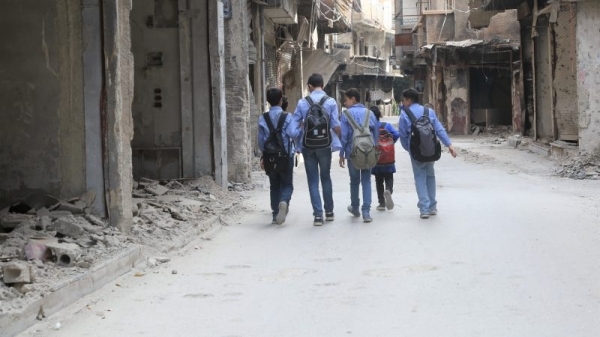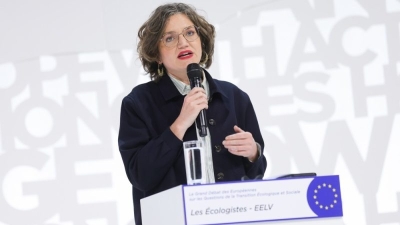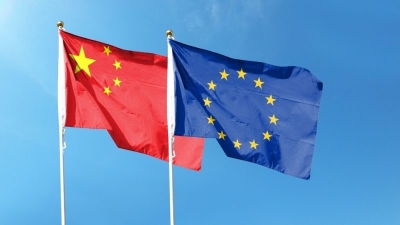What future for Palestine refugees in Syria?

Ahead of the Brussels conference on Syria, Amanya Michael-Ebye reflects on the 12 years of conflict and multiple hardships for Palestine refugees, calling on the EU and the international community for support.
I recently met Sham and Ghena in Homs, in central Syria. Both are young Palestine refugees who study in Al-Ramleh UNRWA school, the UN agency for Palestine refugees. They asked me, on behalf of their classmates, to make sure that their school remains open. There was something so compelling yet so simple about their request: two little girls asking to be able to go to school is beautiful and heartbreaking at the same time.
After six years in Syria, I cannot help but wonder what the future holds for Palestine refugees in this country, especially young ones like Sham and Ghena. Since my arrival, and through my work at UNRWA, I have witnessed first-hand extreme pain and loss, of a scope and scale that are radically different from other places where I had previously served, including the Democratic Republic of Congo, Jordan, Sudan, Tanzania, Uganda and Rwanda.
When the gruelling Syria conflict began, Palestine refugees were among the hardest hit. Three camps – Yarmouk, Dera’a and Ein el Tal – were almost entirely destroyed in the fighting, and most of their residents displaced inside the country and outside it.
Many Palestine Refugees fled to Lebanon, Jordan, Egypt, Europe and beyond. Entire families were separated and almost everyone lost loved ones. Many struggled to find shelter and food, while surviving trauma and loss.
As various political and humanitarian actors prepare for the 7th Brussels Conference on Syria, it is crucial that we remember the Palestine refugee community and that names such as Yarmouk, Deraa and Ein el Tal remain present in discussions around supporting people in Syria.
Ten years after Yarmouk
Palestine refugees arrived in Syria following the 1948 war and settled in different parts of the country. The largest Palestinian community found refuge in Yarmouk camp, which became for decades a hub, or what many Palestinians called “the capital of the Palestinian diaspora”. Sadly though, it also later became the epicentre of massive fighting, displacement and destruction.
Even UNRWA buildings, such as schools and health centres were destroyed in the fighting, making them impossible to use. Today, although the camp is still in ruins, families who can no longer afford to rent outside, after having lost their homes in it, are returning to live amidst debris and rubble.
With support from our committed donors, we started to rehabilitate a few UNRWA buildings and hope to be able to use them later this year. In Dera’a camp, south of Syria, UNRWA was able to rehabilitate most of its damaged buildings, and we now have a school, a health centre and a community centre that are fully functioning.
Funding is urgently needed to rebuild Ein el Tal in Aleppo, a camp that was heavily destroyed during the fighting around the city and recently hit by the earthquake that devastated parts of Türkiye and Syria.
Funding shortages, increasing needs
In 2023, while the fighting has almost finally stopped, many challenges remain. Prior to the conflict, only 6% of Palestine refugees were among the most vulnerable in Syria. Today four out of five Palestine refugees in Syria live in poverty.
UNRWA provides essential services to some 438,000 Palestine refugees who remain in the country: education, healthcare, psychosocial support and counselling to survivors of gender-based violence, and emergency cash and food assistance to the poorest.
It runs 102 schools where nearly 50,000 girls and boys receive quality education and feel a return to normality, and that is probably our most important contribution to a generation that has witnessed tragic events and trauma.
While nearly one-third of our UNRWA schools were damaged, we were able to continue delivering education through schools provided by the Syrian government.
The agency faces debilitating funding shortages every year though. This translates into a limited ability to respond to increasing hardship and layers of crises in the lives of Palestine refugees: An initial displacement, years of conflict that caused other displacements, COVID-19, a deep socio-economic crisis and, most recently, the earthquake.
More than 46,500 Palestine refugees in Syria were affected by this natural disaster and 20 died. Many houses were damaged. This added to years of shock and trauma.
Despite the urgent needs, the UNRWA earthquake appeal still requires nearly US $4 million. This is in addition to the need to be covered under the Agency’s Emergency Appeal for 2023. In Syria, a funded appeal means lifesaving humanitarian assistance, including food and cash, and it means health and education to tens of thousands of Palestinian refugees.
UNRWA remains the main lifeline for Palestine refugee families in Syria, and for those who fled to Lebanon and Jordan during the conflict. The European Union has been a crucial partner in supporting UNRWA’s operations in the region, including in Syria.
Since 1971, we have maintained a strategic partnership governed by the shared objective of supporting the human development and the humanitarian needs of Palestine refugees, pending a just lasting solution to the conflict.
Ahead of the next Brussels Conference on Syria, I am asking that we do all we can for Sham, Ghena and thousands of Palestine refugee children who continue to go to UNRWA schools.
I am asking that their families and community continue to receive health services in UNRWA health centres. I am calling on the EU and all participants at the conference not to forget Palestine refugees, and to make attention and money available for their humanitarian needs.
They are part and parcel of Syrian society and must be included in the humanitarian response in the region. As participants pledge support to the people of Syria, Palestine refugees must be included.



